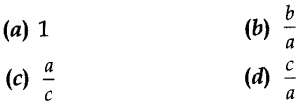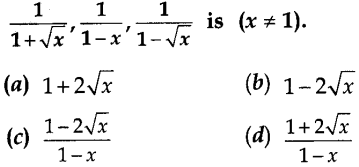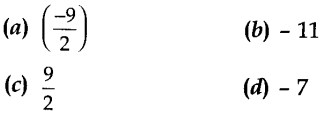Free PDF Download of CBSE Class 10 Maths Chapter 2 Polynomials Multiple Choice Questions with Answers. MCQ Questions for Class 10 Maths with Answers was Prepared Based on Latest Exam Pattern. Students can solve NCERT Class 10 Maths Polynomials MCQs with Answers to know their preparation level. https://www.cbselabs.com/mcq-questions-for-class-10-maths-polynomials-with-solutions/
Class 10 Maths MCQs Chapter 2 Polynomials
Polynomials Class 10 MCQ
1. If one zero of the quadratic polynomial x² + 3x + k is 2, then the value of k is
(a) 10
(b) -10
(c) 5
(d) -5
Answer
Answer: b
Is this a Polynomial Calculator is a free online calculator tool.
Polynomial Class 10 MCQ
2. Given that two of the zeroes of the cubic poly-nomial ax3 + bx² + cx + d are 0, the third zero is

Answer
Answer: a
Polynomial MCQ Class 10
3. If one of the zeroes of the quadratic polynomial (k – 1) x² + kx + 1 is – 3, then the value of k is

Answer
Answer: a
Class 10 Polynomials MCQ
4. A quadratic polynomial, whose zeroes are -3 and 4, is
(a) x²- x + 12
(b) x² + x + 12
(c) \(\frac{x^{2}}{2}-\frac{x}{2}-6\)
(d) 2x² + 2x – 24
Answer
Answer: c
Polynomials MCQ Class 10
5. If the zeroes of the quadratic polynomial x2 + (a + 1) x + b are 2 and -3, then
(a) a = -7, b = -1
(b) a = 5, b = -1
(c) a = 2, b = -6
(d) a – 0, b = -6
Answer
Answer: d
MCQ Of Polynomials Class 10
6. The number of polynomials having zeroes as -2 and 5 is
(a) 1
(b) 2
(c) 3
(d) more than 3
Answer
Answer: d
Polynomials Class 10 MCQ With Answers
7. Given that one of the zeroes of the cubic polynomial ax3 + bx² + cx + d is zero, the product of the other two zeroes is

Answer
Answer: b
MCQ On Polynomials Class 10
8. If one of the zeroes of the cubic polynomial x3 + ax² + bx + c is -1, then the product of the
other two zeroes is
(a) b – a + 1
(b) b – a – 1
(c) a – b + 1
(d) a – b – 1
Answer
Answer: a
Class 10 Maths Polynomials MCQ
9. The zeroes of the quadratic polynomial x2 + 99x + 127 are
(a) both positive
(b) both negative
(c) one positive and one negative
(d) both equal
Answer
Answer: b
Polynomial MCQ
10. The zeroes of the quadratic polynomial x² + kx + k, k? 0,
(a) cannot both be positive
(b) cannot both be negative
(c) are always unequal
(d) are always equal
Answer
Answer: a
Polynomials Class 10 MCQ With Explanation
11. If the zeroes of the quadratic polynomial ax² + bx + c, c # 0 are equal, then
(a) c and a have opposite signs
(b) c and b have opposite signs
(c) c and a have the same sign
(d) c and b have the same sign
Answer
Answer: c
MCQ Polynomials Class 10
12. If one of the zeroes of a quadratic polynomial of the form x² + ax + b is the negative of the other, then it
(a) has no linear term and the constant term is negative.
(b) has no linear term and the constant term is positive.
(c) can have a linear term but the constant term is negative.
(d) can have a linear term but the constant term is positive.
Answer
Answer: a
Polynomials MCQ
13. Which of the following is not the graph of quadratic polynomial?

Answer
Answer: d
14. The number of polynomials having zeroes as 4 and 7 is
(a) 2
(b) 3
(c) 4
(d) more than 4
Answer
Answer: d
15. A quadratic polynomial, whose zeores are -4 and -5, is
(a) x²-9x + 20
(b) x² + 9x + 20
(c) x²-9x- 20
(d) x² + 9x- 20
Answer
Answer: b
16. The zeroes of the quadratic polynomial x² + 1750x + 175000 are
(a) both negative
(b) one positive and one negative
(c) both positive
(d) both equal
Answer
Answer: a
17. The zeroes of the quadratic polynomial x² – 15x + 50 are
(a) both negative
(b) one positive and one negative
(c) both positive
(d) both equal
Answer
Answer: c
18. The zeroes of the quadratic polynomial 3x² – 48 are
(a) both negative
(b) one positive and one negative
(c) both positive
(d) both equal
Answer
Answer: b
19. The zeroes of the quadratic polynomial x² – 18x + 81 are
(a) both negative
(b) one positive and one negative
(c) both positive and unequal
(d) both equal and positive
Answer
Answer: d
20. The zeroes of the quadratic polynomial x² + px + p, p ≠ 0 are
(a) both equal
(b) both cannot be positive
(c) both unequal
(d) both cannot be negative
Answer
Answer: b
21. If one of the zeroes of the quadratic polynomial (p – l)x² + px + 1 is -3, then the value of p is
Answer
Answer: b
22. If the zeroes of the quadratic polynomial Ax² + Bx + C, C # 0 are equal, then
(a) A and B have the same sign
(b) A and C have the same sign
(c) B and C have the same sign
(d) A and C have opposite signs
Answer
Answer: b
23. If x3 + 1 is divided by x² + 5, then the possible degree of quotient is
(a) 0
(b) 1
(c) 2
(d) 3
Answer
Answer: b
24. If x3 + 11 is divided by x² – 3, then the possible degree of remainder is
(a) 0
(b) 1
(c) 2
(d) less than 2
Answer
Answer: d
25. If x4 + 3x² + 7 is divided by 3x + 5, then the possible degrees of quotient and remainder are:
(a) 3, 0
(b) 4, 1
(c) 3, 1
(d) 4, 0
Answer
Answer: a
26. If x5 + 2x4 + x + 6 is divided by g(x), and quotient is x² + 5x + 7, then the possible degree of g(x) is:
(a) 4
(b) 2
(c) 3
(d) 5
Answer
Answer: c
27. If x5 + 2x4 + x + 6 is divided by g(x) and quo-tient is x² + 5x + 7, then the possible degree of remainder is:
(a) less than 1
(b) less than 2
(c) less than 3
(d) less than 4
Answer
Answer: c
28. What is the number of zeroes that a linear poly-nomial has/have:
(a) 0
(b) 1
(c) 2
(d) 3
Answer
Answer: b
29. What is the number(s) of zeroes that a quadratic polynomial has/have:
(a) 0
(b) 1
(c) 2
(d) 3
Answer
Answer: c
30. What is the number(s) of zeores that a cubic polynomial has/have:
(a) 0
(b) 1
(c) 2
(d) 3
Answer
Answer: d
31. If one of the zeroes of the cubic polynomial x3 + px² + qx + r is -1, then the product of the other two zeroes is
(a) p + q + 1
(b) p-q- 1
(c) q – p + 1
(d) q – p – 1
Answer
Answer: c
32. If one zero of the quadratic polynomial x² + 3x + b is 2, then the value of b is
(a) 10
(b) -8
(c) 9
(d) -10
Answer
Answer: d
33. If 1 is one of the zeroes of the polynomial x² + x + k, then the value of k is:
(a) 2
(b) -2
(c) 4
(d) -4
Answer
Answer: b
We hope the given MCQ Questions for Class 10 Maths Polynomials with Answers will help you. If you have any query regarding CBSE Class 10 Maths Chapter 2 Polynomials Multiple Choice Questions with Answers, drop a comment below and we will get back to you at the earliest.
















